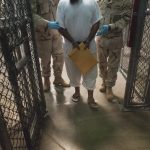For years, much has been reported on the abhorrent practice of waterboarding during the United States’ “War on Terror” – but, until recently, less has been said about other forms of torture that were perpetrated by Americans on CIA detainees. With the nomination of Gina Haspel for CIA director, the spotlight has now been shone on a notorious CIA “black site” prison, the name and location of which are widely known in open sources but which officially remain classified. We’ve heard about the controversial practices and we’ve read about videotaped evidence being destroyed. But not much has been revealed about what exactly happened at this black site.
We have spent a combined 40 years evaluating torture survivors, and our unique, intimate perspective leads us to just one conclusion: confirming Haspel to lead the CIA would be unconscionable.
Prisoners at the black site were kept naked in pitch black cells with their wrists and ankles shackled to one ring on the wall while loud music blared out 24 hours a day; rats and insects crawled over the men in cells that were either freezing cold or unbearably hot. So horrific were the conditions between interrogations that one prisoner reportedly preferred the “official” torture sessions, since they allowed him to move from his cell.
The enduring suffering inflicted by the CIA in this secret prison is as bad as what we witnessed in prisoners tortured under the brutal regimes of Libya’s Muammar Gadhafi, Syrian President Bashar al-Assad, and ISIS.
Physicians for Human Right (PHR) in 2014 documented how the CIA torture program relied heavily on health professionals to carry out its “enhanced interrogation,” ostensibly to add a layer of perceived legitimacy to the torture techniques. Using doctors to enforce torture, and clinical psychologists to design it, profoundly violated the ethical duty to “do no harm” and went against everything that clinicians like us stand for. The harm those health professionals helped inflict is substantial.
Of the dozens of men tortured by U.S. and NATO forces whom we have evaluated, two were plaintiffs in the Salim v. Mitchell case. This case involved two CIA-contracted clinical psychologists, James Mitchell and Bruce Jessen, who were accused of designing and implementing a torture program at CIA black sites. The plaintiffs, Gul Rahman – represented by his uncle because Rahman was tortured to death – Suleiman Abdullah Salim, and Mohamed Ahmed Ben Soud were severely tortured in the same secret prison. In defending their claim, Mitchell and Jessen sought to depose Haspel for her role in the men’s torture, claiming that “Ms. Haspel was centrally involved in the events alleged.”
The justification for the “enhanced interrogations” – which were approved by the Justice Department – was partly based on the claim that the techniques did not cause lasting harm, and thus did not amount to torture. Part of the evidence used to substantiate this false claim was that some of these techniques had previously been used by British government operatives on people suspected of being in the Irish Republican Army. But clinicians who assessed the Irish survivors of these interrogations have publicly spoken of the lasting, irrevocable harm perpetrated against them.
Similarly, the torture conducted in the “War on Terror” has caused irreparable damage to many of its victims. One of us has personally been seeing one of the so-called high value prisoners kept at Guantánamo Bay detention center over the last six years, and can confirm that he was brutally tortured – physically, psychologically, and sexually. He is permanently damaged by the torture program designed to break him.
The pain, suffering, and long-term harm inflicted on these men, their families, and their communities is immense. Rahman was tortured to death. Salim and Soud were lucky to escape with their lives, but carry psychological and physical scars that will last a lifetime – and we must never forget that both Salim and Soud were released without charges, as were most of the men tortured by the CIA.
The ongoing effect of the U.S. decision to torture terror suspects is profound. The use of torture has impeded bringing the alleged perpetrators of these terrorist attacks to justice. There is still no closure or justice for the families and survivors of the bombing of the USS Cole or the attacks of 9/11. Those of us who have the clearance to be present at Guantánamo during a hearing have seen their pain up close.
What torture has accomplished instead is to make Americans, including our service members, less safe around the world. And perhaps most dangerously, the United States has lost moral authority and negotiating power to confront other dangerous and oppressive regimes, such as Russia and North Korea, on human rights issues.
Since World War II, the United States and the UK have been among those nations that have repudiated torture as a war crime and a crime against humanity. Yet, now, the United States is on the cusp of promoting someone to direct the CIA who allegedly played a leadership role in the agency’s shameful torture program – someone who should instead be prosecuted for her crimes. As doctors who understand the long-range, devastating effects of torture, we oppose Gina Haspel’s nomination, and hope the U.S. Senate will have the courage to do so as well.
Sondra Crosby, MD, is an associate professor of medicine and public health at Boston University who specializes in torture and trauma treatment. She is also a medical consultant for Physicians for Human Rights.
Brock Chisholm, MSC, Dclin (Psych), is a consultant clinical psychologist and also specializes in torture and trauma treatment. He is a founder of the charity Trauma Treatment International and director of Criterion A Psychology Services in London.
The views expressed in this article are those of the authors and do not reflect the official policy, the position of the Department of Defense or the U.S. Government, nor do they necessarily reflect the views of the institutions that the authors work for or are associated with.

